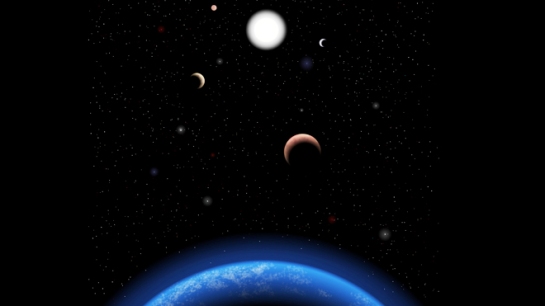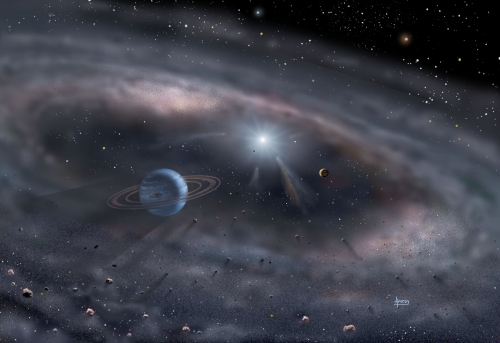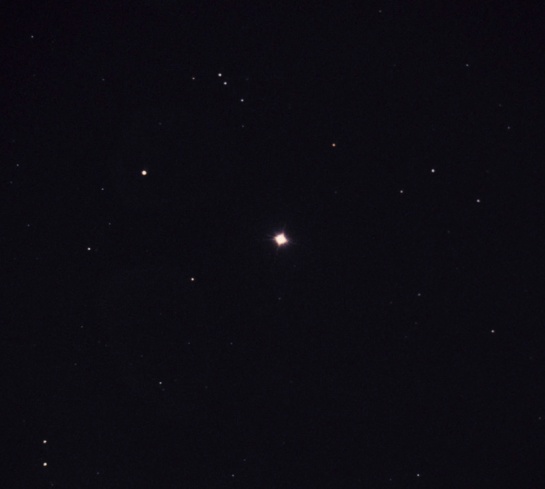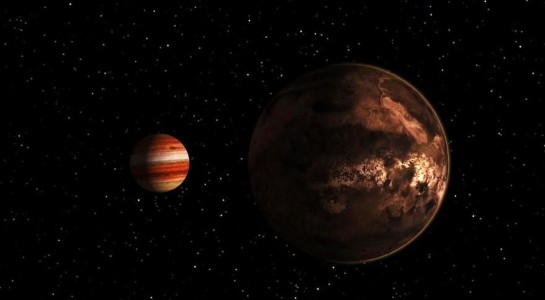A star that is a mainstay of science fiction has surged ahead in the race to find life-friendly alien planets. If the discovery of two planets orbiting Tau Ceti is confirmed, they will be the closest potentially habitable exoplanets yet discovered.
Planets form around a young star in this artist’s concept. Using the Keck Interferometer in Hawaii, astronomers have probed the structure of a dust disk around MWC 419 to within 50 million miles of the star.
Via NASA, Credit: David A. Hardy/www.astroart.org
Tau Ceti’s proximity and similarity to our sun have captured the imagination of writers and made it a promising candidate for life outside our solar system. The star was the target of one of the earliest searches for extraterrestrial life, in 1960, but astronomers had been struggling to see any hints of orbiting planets.
Now Hugh Jones at the University of Hertfordshire, UK, and colleagues have reanalysed observations of Tau Ceti using a new technique that can filter out noise to reveal previously hidden planets. The team discovered five potential planets ranging from two to nearly seven times the mass of Earth, with orbits ranging from 14 to 640 Earth days long.
The highlight of this alien solar system is Tau Ceti e, which has a mass of over four Earths and a year just under half as long as ours. It orbits in the star’s habitable zone, the region where liquid water is thought to exist. “It is in the right place to be interesting,” says Jones. Read More
~~~~~~~~~~~~~~~~~~~~~~~~~~

- Artist’s impression of five possible planets orbiting the star Tau Ceti, which is just 11.9 light-years from Earth.J. Pinfield / University
http://www.foxnews.com
A nearby planetary system? Via Huffington Post
The five planets remain candidates at this point and will not become official discoveries until they’re confirmed by further analysis or observations. And that’s not a sure thing, researchers said.
“I am very confident that the three shortest periodicities are really there, but I cannot be that sure whether they are of planetary origin or some artifacts of insufficient noise modelling or stellar activity and/or magnetic cycles at this stage,” Tuomi said, referring to the potential planets with orbital periods of 14, 35 and 94 days (compared to 168 days for the habitable zone candidate and 640 days for the most distantly orbiting world).
“The situation is even worse for the possible habitable zone candidate, because the very existence of that signal is uncertain, yet according to our detection criteria the signal is there and we cannot rule out the possibility that it indeed is of planetary origin,” he added. “But we don’t know what else it could be, either.
If the Tau Ceti planets do indeed exist, their proximity would make them prime targets for future instruments to study, researchers said.
“Tau Ceti is one of our nearest cosmic neighbors and so bright that we may be able to study the atmospheres of these planets in the not-too-distant future,” James Jenkins, of the Universidad de Chile and the University of Hertfordshire, said in a statement. “Planetary systems found around nearby stars close to our sun indicate that these systems are common in our Milky Way galaxy.”
If confirmed, the Tau Ceti planets would not be the closest exoplanets to Earth. That title still goes to Alpha Centauri Bb, a roasting-hot, rocky world recently spotted just 4.3 light-years away, in the closest star system to our own.
The new study has been accepted for publication in the journal Astronomy & Astrophysics.
Follow SPACE.com senior writer Mike Wall on Twitter @michaeldwallor SPACE.com @Spacedotcom. We’re also on Facebookand Google+.
- The Nearest Stars to Earth (Infographic)
- Possibly Habitable Super-Earths – Catalog To Date | Video
- 6 Most Likely Places for Alien Life in the Solar System
Planet that orbits a sun visible to the naked eye: by John Hall
Scientists have discovered a ‘habitable’ planet that orbits a sun visible to the naked eye.
The world is just 12 light years away, is between two and six times bigger than the earth, and is thought to be circling Tau Ceti, a star almost identical to our sun.
The planet is one of five orbiting Tau Ceti, and lies within the star’s habitable zone. It is thought to have five times the Earth’s mass.
Also known as the “Goldilocks zone”, the habitable zone is the orbital region that is neither too hot nor too cold to allow liquid surface water and, potentially, life.
Details of the discovery are to appear in the journal Astronomy & Astrophysics.
Because of the difficulties involved in detecting extra-solar planets, most found so far have had high masses.
The Tau Ceti planetary family is thought to be the lowest mass solar system yet detected.
Scientists found the planets using a highly sensitive technique that combined data from more than 6,000 observations from three different telescopes.
They used the radial velocity method which looks for “wobble” in a star’s movement caused by the gravitational tug of planets.
Dr James Jenkins, a member of the international team from the University of Hertfordshire, said: “Tau Ceti is one of our nearest cosmic neighbours and so bright that we may be able to study the atmospheres of these planets in the not-too-distant future.
”Planetary systems found around nearby stars close to our sun indicate that these systems are common in our Milky Way galaxy.“
More than 800 planets have been discovered orbiting stars beyond the sun since the 1990s.
Those found around the nearest sun-like stars are the most interesting to astronomers.
Professor Steve Vogt, another team member from the University of California at Santa Cruz, said: ”This discovery is in keeping with our emerging view that virtually every star has planets, and that the galaxy must have many such potentially habitable Earth-sized planets. They are everywhere, even right next door.“
Professor Chris Tinney, an Australian member from the University of New South Wales, said: ”As we stare at the night sky, it is worth contemplating that there may well be more planets out there than there are stars, some fraction of which may well be habitable.“
Dr Jenkins is a visiting fellow at the University of Hertfordshire who is based at the University of Chile.
~~~~~~~~~~~~~~~~~~~~~~~~~~~~~~~~~~~~~~~
Search Results of TAU CETI at NASA
The Star
Tau Ceti is a main sequence, yellow-orange dwarf (G8 Vp). Smaller and dimmer than Sol, the star has around 81 to 92 percent of Sol’s mass (SIM project; and NASA Star and Exoplanet Database, interpolated from a table by David F. Gray, 1992), although analysis of the star’s oscillations of half Sol’s amplitude leads to a mean density combined with its interferometric radius that suggests around only 0.783 +/-0.012 Solar-mass (Teixeira et al, 2009). The star may have around 75 to 77 percent of Sol’s diameter (Pijpers et al, 2003; and NASA Star and Exoplanet Database, derived from a power law formula by Kenneth R. Lang, 1980), but only 59 percent of its visual(?) luminosity (Saumon et al, 1996, Table 1, page 1009) and 46.5 +/-0.3 percent to 53 percent of its bolometric luminosity (SIM project; and NASA Star and Exoplanet Database, derived from the exponential formula of Kenneth R. Lang, 1980). It appears to be elderly for a main sequence dwarf, perhaps around 10 billion years old (Di Folco et al, 2007), but another study suggests that it only somewhat older than Sol at 5.8 billion years (Mamajek and Hillebrand, 2008).
The star does not appear to be as enriched as Sol in elements heavier than hydrogen (“metals”), with only 22 to 89 percent of Sol’s abundance of iron (Soubiran et al, 1998; and Cayrel de Strobel et al, 1991, page 6). It rotates more slowly than Sol with a period at 34 days (Baliunas et al, 1996) and appears to be further along in core hydrogen-fusion, with a relatively weak 11-year cycle of star spots and related chromospheric activity. Due to its slow rotational period, some astronomers proposed that the star is viewed pole-on from Earth (Gray and Baliunas, 1994), but others have speculated that Tau Ceti may be experiencing a phase like the Solar Maunder minimum (Judge et al, 2004). Given its its moderately high velocity through space, Tau Ceti may be a temporary visitor from the galaxy’sthick disk (see more discussion from Professor Jim Kaler).
Dust has been detected around Tau Ceti, as has been found in the Solar System (Kuchner et al, 1998 — in pdf — more discussion below). The star appears to have a dim optical stellar companion, possibly a red dwarf of 13th magnitude that is seen in telescopes but is probably not actually bound by gravity to Tau Ceti itself. In addition, Tau Ceti does not appear to have a close stellar or substellar companion based on astrometric measurements (Lippincott and Worth, 1980), radial velocity variations (Campbell et al, 1988; and near-infrared interferometry (Di Folco et al, 2007). Some useful star catalogue numbers for Tau Ceti are: Tau Cet, 52 Cet, HR 509, Gl 71, Hip 8102, HD 10700, BD-16 295, SAO 147986, FK5 59, LHS 146, LTT 935, LPM 84, and LFT 159.
Habitable Zone
According to one type of model calculations performed for the NASA Star and Exoplanet Database, the inner edge of Tau Ceti’s habitable zone is located relatively far from the star at around 0.582 AUs from the star, while the outer edge lies even farther out at around 1.157 AUs. According to the SIM project, the distance from Tau Ceti where an Earth-type planet would be “comfortable” with liquid water is centered around only 0.74 AU — between the orbital distance of Venus and Earth in the Solar System. Assuming that Tau Ceti has 92 percent of Sol’s mass, such a planet would have an orbital period under 240 days — less than two-thirds of an Earth year — at that distance from the star. (For an illustrated discussion, see Christoph Kulmann’s web page on the potential habitable zone around Tau Ceti.)
On December 19, 2012, a team of astronomers announced the possible detection of five planets in relatively circular orbits around Tau Ceti, with periods of 14.0, 35.4, 94.1, 168, and 642 days with a minimum of 2.0, 3.1, 3.6, 4.3, and 6.6 Earth-masses, respectively. The team applied “noise modelling” to subtract noise and thereby find the smallest signals hiding in the data from Tau Ceti, on which there is a lot of radial-velocity data from three different planet-hunting missions: HARPS, AAPS, and HiRes. They put in “fake planets” to add signals into the messy data emulating what planets would add and found ways to reduce the noise until the fake planets became more and more visible in the data, in the process of which they actually detected real signals as well. One of planetary candidates, designated “HD 10700 e,” lies about half as far from Tau Ceti as the Earth is from the Sun which lies in the habitable zone of Tau Ceti because it is slightly smaller and dimmer than our own Sun, Sol (press release; BBC News, December 19, 2012; Astrobiology, December 19, 2012; and Tuomi et al, 2012).
And From Adelaide, Australia:
FORGET the Mayan apocalypse and little green men from Mars: Alien invaders may be living as little as 12 light years away – and they may have already visited.
Tau Ceti – the closest star of a type similar to our own Sun – has been found to have at least five planets orbiting it. Scientists say one of those planets sits neatly in the “goldilocks” habitable zone.
And if you think the name sounds familiar, you’re right. The star features in many works of science fiction, from the movie Barbarella to episodes of Star Trek and novels from Isaac Asimov and Robert Heinlein.
The announcement comes as archaeologists announce the discovery of “alien” skulls – right at the height of the Mayan apocalypse and Starchild conspiracy theory frenzies.
The skulls, actually from humans belonging to a culture which deliberately distorted the shapes of heads from birth, are being exhumed near a village called Onavas in Mexico.
Dated as about 1000 years old, one skull in particular has the elongated cone shape which features so often in science fiction depictions of alien life.
Director of the research project Cristina Moreno of Arizona State University says, “Cranial deformation in Mesoamerican cultures was used to differentiate one social group from another and for ritual purposes.”

Tau Ceti, one of the closest stars similar in type to our own Sun, has been found to contain a planet in its habitable zone. Concept picture: NASA Source: Supplied
So are we at risk from invasion from Tau Ceti?
No. And there’s evidence to back it up.
In the 1960s, the budding SETI (search for extraterrestrial intelligence) program monitored the star closely for artificial radio signals.
It came up blank. The Full Story From Adelaide Now>>>
Story from Universe Today.. Back in 2004:
“Asteroids Make Tau Ceti Lethal”
Astronomers studying the Tau Ceti system have discovered that it contains ten times as much material in the form of asteroids and comets as our own solar system.
Tau Ceti, only 12 light years away, is the nearest sun-like star and is easily visible without a telescope. It is the first star to be found to have a disk of dust and comets around it similar in size and shape to the disk of comets and asteroids that orbits the Sun.
The astronomers’ discovery, being published in Monthly Notices of the Royal Astronomical Society, suggests that even though Tau Ceti is the nearest Sun-like star, any planets that may orbit it would not support life as we know it due to the inevitable large number of devastating collisions. It also suggests that the tranquil space environment around the Earth may be more unusual than previously realized.
Though the star Tau Ceti is similar to the Sun, any planets it has are unlikely to be havens for life, say a team of UK astronomers. Using submillimeter images of the disk of material surrounding Tau Ceti, they found that it must contain more than ten times as many comets and asteroids than there are in the Solar System. Read more>>
Related articles
- New planet discovered in habitable zone – TODAYonline (todayonline.com)
- New Planet In ‘Goldilocks Zone’ Might Support Life (news.sky.com)
- Possible life supporting planet found (stuff.co.nz)
- Five Planets Around Nearby Star Tau Ceti; One in Habitable Zone (universetoday.com)







